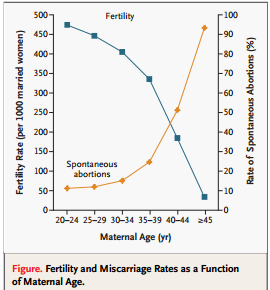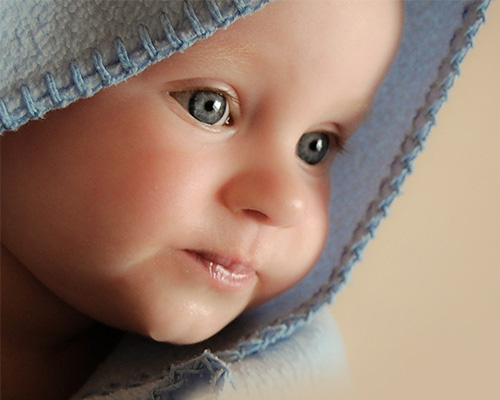In Vitro Fertilization & Tubal Reversal
Just because a person had few complications with pregnancy or fertility in their twenties, does not mean that they will be as fortunate in their thirties or forties. The chance of success depends on the quality of the eggs being produced. The eggs of women as young as 33 are known to have more abnormalities that result in decreased pregnancy rates and increased miscarriages as compared to younger women. The trend continues and worsens much more quickly after the age of 36. This is why older women have fewer pregnancies and more miscarriages.
This is why almost all egg donation centers limit the age of egg donors to 32 or less. Our center’s cut-off is 30. The graph below demonstrates decreasing pregnancy rates as well as an increasing risk of miscarriage when patients are older. Please review the PGD section of this web site as well as the general infertility section for more information.

Risk of Down’s Syndrome and Chromosomal Abnormalities at Live Birth, According to Maternal Age
| Maternal Age at Birth | Risk of Down’s Syndrome   | Risk of a Chromosome Problem |
|---|---|---|
| 20 | 1/1667 | 1/526 |
| 25 | 1/1200 | 1/476 |
| 30 | 1/952 | 1/385 |
| 35 | 1/378 | 1/192 |
| 40 | 1/106 | 1/66 |
| 45 | 1/30 | 1/21 |
Data for table modified from Hook et al from Chromosomal Abnormality rates at amniocentesis and Live born Infants. JAMA 1983; 249:2034-8
An older woman with a prior “unfavorable type” of tubal ligation may choose to go through the IVF program because she desires the highest chance of pregnancy in a short interval of time. A younger woman with the same “unfavorable type” of tubal ligation may choose to try the tubal ligation reversal because she has more time to conceive than the more mature woman. The younger woman has the luxury of being able to wait on IVF without a significant drop in her chance of a pregnancy.
The best results after tubal reversal are those of the particular age of the patient. The monthly chance of pregnancy for a normal couple in their mid-twenties is 20-25%. This decreases with age.
In the 1950s a group of immigrants from Switzerland called the Hutterites who live in the Northwest states was studied. They are a religious sect who live in a communal fashion and do not practice contraception. Only 5 of 209 women were infertile (a low infertility rate of only 2.4%). The average age at the time of the last pregnancy was 40.9 years. Eleven percent of women had no more children after the age of 34. 33% of the women were infertile by age 40. 87% were infertile by age 45.
Age of the female partner has been shown in many studies to be the most important factor for pregnancy success. A patient can have the most perfectly repaired tubes but fail to conceive because of age. Older patients don’t have as much time to conceive. Age is sometimes an incentive to proceed with IVF because several months of trying to conceive can be “compressed” into one treatment due to the recruitment of multiple eggs that is routine in IVF.

Your Next Step:
Get your consultation time
by clicking the button below
or by calling 941-342-1568.
